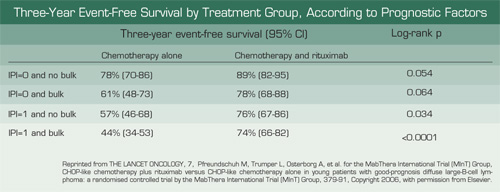In Brief
DLBCL is the most common non-Hodgkin lymphoma subtype in the western world, and is both clinically and biologically heterogeneous. This important trial confirms and extends earlier studies and establishes R-CHOP as a current standard for younger as well as older patients with DLBCL. There was no clear benefit to those who received R-CHOEP as compared with R-CHOP, suggesting to these authors that rituximab has a "chemo-equalizing" effect or that the more intensive and toxic CHOEP regimen impaired immune effector mechanisms important to rituximab response. The identification of a highly favorable subgroup of very low-risk patients (IPI 0, non-bulky) suggests that they should be treated and studied in future clinical trials separately from DLBCL patients with greater degrees of risk. The addition of rituximab to CHOP has provided an important but incremental advance in DLBCL, and it remains essential to continue to build upon this progress. To this end, current clinical research in previously untreated DLBCL includes dose-modulated chemo-immunotherapy (e.g., dose-adjusted R-EPOCH or dose-dense R-CHOP), R-CHOP followed by radioimmunotherapy consolidation, and risk stratification for early stem cell transplantation based upon clinical IPI score, phenotypic or molecular markers, and PET response after 2-3 cycles of induction chemotherapy.
Competing Interests
Dr. Williams receives research funding from BiogenIDEC and Genentech.

